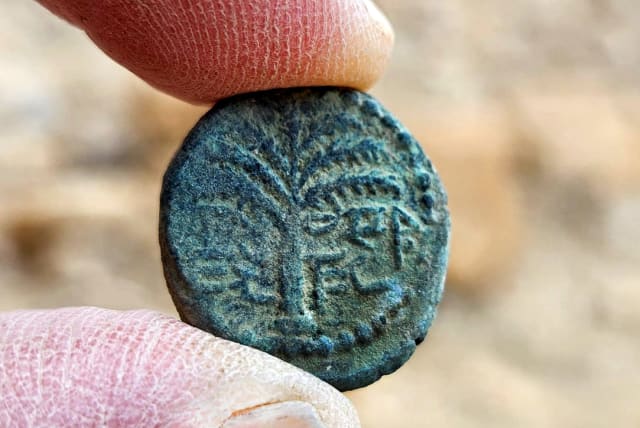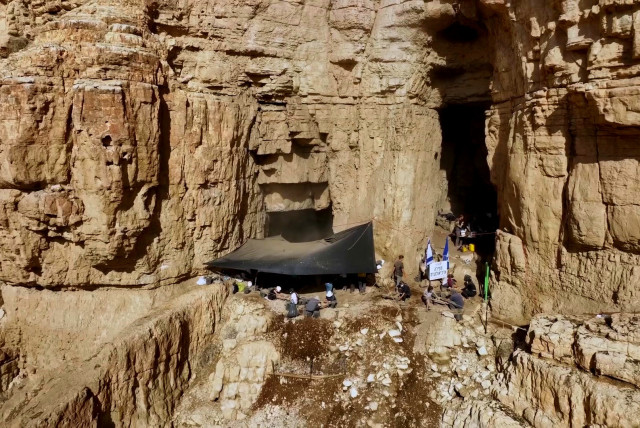Rare coin from the Bar Kochba Revolt discovered in Judean Desert

Since 2017, a team of archaeologists from the IAA’s Prevention of Archaeological Theft unit has been systematically surveying the Judean Desert to reach valuable finds before the antiquity looters.
The inscription “Year One of the Redemption of Israel” appears on a rare coin from the time of the Bar Kochba Revolt, bearing the name of “Eleazar the Priest” and dated to the first year of the revolt (132 CE), has been found in the course of the Judean Desert Cave Survey carried out by the Israel Antiquities Authority (IAA).
The dig at the Mazuq Ha-he'teqim Nature Reserve, whose aim is to retrieve the ancient treasures before they are stolen by antiquity looters, is being carried out in cooperation with the Ministry of Heritage and the Archaeological Office for the Military Administration of Judea and Samaria. Three additional Revolt coins bearing the name “Simeon” were also found with the rare coin.
Members of the public are invited to the excavation
Interested public members are invited to participate in the excavation season in the desert, which will begin on March 11 and last for ten days. The volunteers will stay in a camp set up in the desert by the IAA and will be able to hear and participate in other activities. Registration and details are on the Hebrew-language site of the IAA at https://www.iaa.org.il/.
There are a few theories about the identity of Eleazar the Priest, whose name appears on the coin. One is Rabbi Eleazar Hamod‘ai, a Tannaic rabbi from the time of Rabbi Akiva, a pupil of Rabbi Yohanan ben Zakai. It seems that Rabbi Eleazar Hamod‘ai played a significant religious role at the time of the Bar Kochba Revolt, and he was living in the town of Beitar – the location of the revolt headquarters. The Talmud accounts that he died in Beitar, probably during the Revolt. (Jerusalem Talmud: Ta‘anit 4:5).
On the obverse face of the coin, a date palm is engraved with “Eleazar the Priest” inscribed in ancient Hebrew script. On the reverse, a bunch of grapes is surrounded by the text “Year One of the Redemption of Israel,” again in ancient Hebrew script.
Since 2017, a team of archaeologists from the IAA’s Prevention of Archaeological Theft unit has been systematically surveying the Judean Desert to reach the valuable finds before the antiquity looters. Among the finds discovered in the desert in the course of the survey were scroll fragments of the Twelve Minor Prophets, Roman iron swords – one still in its sheath – and the earliest complete basket in the world, and more.
“We invite the public to join us in the seventh excavation season in the desert to help save the Judean Desert archaeological finds, endangered by antiquities theft,” said IAA director Eli Escuzido.
“They are invited for a taste of Zionism and a touch of ‘escapism,’ volunteering on a dig, together with the IAA archaeological team in the Murabba‘at Caves along Nahal Darga. The Judean Desert excavations do not cease to amaze us, and we hope that in this season, we will also be able to report important finds.”
Jerusalem Post Store
`; document.getElementById("linkPremium").innerHTML = cont; var divWithLink = document.getElementById("premium-link"); if (divWithLink !== null && divWithLink !== 'undefined') { divWithLink.style.border = "solid 1px #cb0f3e"; divWithLink.style.textAlign = "center"; divWithLink.style.marginBottom = "15px"; divWithLink.style.marginTop = "15px"; divWithLink.style.width = "100%"; divWithLink.style.backgroundColor = "#122952"; divWithLink.style.color = "#ffffff"; divWithLink.style.lineHeight = "1.5"; } } (function (v, i) { });

